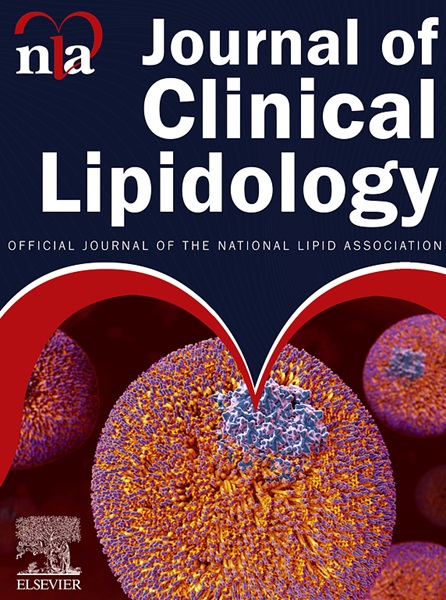Cholesteryl ester transfer protein activity correlates inversely with apolipoprotein A5 levels
IF 4.6
3区 医学
Q2 PHARMACOLOGY & PHARMACY
引用次数: 0
Abstract
BACKGROUND
Cholesteryl ester transfer protein (CETP) mediates the exchange of triglycerides (TG) from apolipoprotein B (ApoB)-containing lipoproteins to high-density lipoproteins (HDL) and the reciprocal exchange of cholesterol (C) from HDL to ApoB-containing lipoproteins. CETP inhibition increases HDL-C and decreases low-density lipoprotein cholesterol (LDL-C) while modestly decreasing TG. Considering that CETP inhibitors block removal of TG from TG-rich lipoproteins (TRL), it is interesting that CETP inhibition decreases TG concentrations. TG levels are largely regulated by lipoprotein lipase (LPL), the enzyme primarily responsible for hydrolyzing TG. The angiopoietin-like 3/8 complex (ANGPTL3/8) is the most potent circulating LPL inhibitor, while the TG-lowering apolipoprotein A5 (ApoA5) acts by suppressing ANGPTL3/8-mediated LPL inhibition.
METHODS
To better understand CETP biology, we studied the effects of CETP overexpression and CETP inhibition on the levels of ANGPTL3/8 and ApoA5 in circulation using dedicated immunoassays.
RESULTS
CETP-overexpressing transgenic mice had increased TG and normal ANGPTL3/8 levels but manifested dramatically reduced ApoA5 concentrations. Administration of the CETP inhibitor evacetrapib had no effect on ANGPTL3/8 levels in CETP-overexpressing mice or in humans. However, evacetrapib administration increased ApoA5 concentrations in both species. In human subjects, evacetrapib treatment increased circulating ApoA5 levels in the late-stage ACCELERATE and ACCENTUATE studies by 160.1% and 204.7%, respectively.
CONCLUSIONS
Our results uncover a previously unrecognized link between CETP and ApoA5 by showing that CETP overexpression reduces ApoA5 levels while CETP inhibition increases ApoA5 concentrations.
胆固醇酯转移蛋白活性与载脂蛋白A5水平呈负相关。
背景:胆固醇酯转移蛋白(CETP)介导甘油三酯(TG)从含载脂蛋白B (ApoB)的脂蛋白到高密度脂蛋白(HDL)的交换,以及胆固醇(C)从HDL到含载脂蛋白B的脂蛋白的相互交换。CETP抑制增加HDL-C,降低低密度脂蛋白胆固醇(LDL-C),同时适度降低TG。考虑到CETP抑制剂阻断TG从富含TG的脂蛋白(TRL)中去除,有趣的是,CETP抑制降低了TG浓度。TG水平在很大程度上受脂蛋白脂肪酶(LPL)的调节,这种酶主要负责水解TG。血管生成素样3/8复合物(ANGPTL3/8)是最有效的循环LPL抑制剂,而降tg载脂蛋白A5 (ApoA5)通过抑制ANGPTL3/8介导的LPL抑制而起作用。方法:为了更好地了解CETP的生物学特性,我们采用专门的免疫分析方法研究了CETP过表达和抑制对循环中ANGPTL3/8和ApoA5水平的影响。结果:过表达cetp的转基因小鼠TG和ANGPTL3/8水平升高,ApoA5浓度显著降低。给药CETP抑制剂evacetrapib对CETP过表达小鼠或人的ANGPTL3/8水平没有影响。然而,给药后,两种动物的ApoA5浓度均升高。在人类受试者中,在晚期ACCELERATE和accentate研究中,evacetrapib治疗使循环ApoA5水平分别提高了160.1%和204.7%。结论:我们的研究结果揭示了CETP和ApoA5之间先前未被认识到的联系,表明CETP过表达降低ApoA5水平,而CETP抑制增加ApoA5浓度。
本文章由计算机程序翻译,如有差异,请以英文原文为准。
求助全文
约1分钟内获得全文
求助全文
来源期刊
CiteScore
7.00
自引率
6.80%
发文量
209
审稿时长
49 days
期刊介绍:
Because the scope of clinical lipidology is broad, the topics addressed by the Journal are equally diverse. Typical articles explore lipidology as it is practiced in the treatment setting, recent developments in pharmacological research, reports of treatment and trials, case studies, the impact of lifestyle modification, and similar academic material of interest to the practitioner.
Sections of Journal of clinical lipidology will address pioneering studies and the clinicians who conduct them, case studies, ethical standards and conduct, professional guidance such as ATP and NCEP, editorial commentary, letters from readers, National Lipid Association (NLA) news and upcoming event information, as well as abstracts from the NLA annual scientific sessions and the scientific forums held by its chapters, when appropriate.

 求助内容:
求助内容: 应助结果提醒方式:
应助结果提醒方式:


